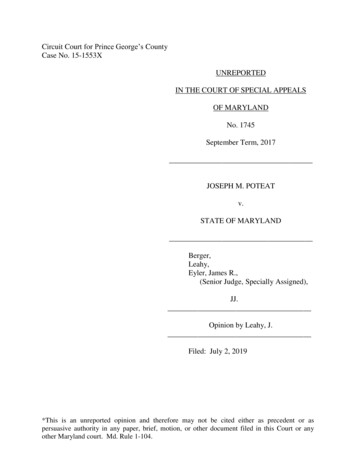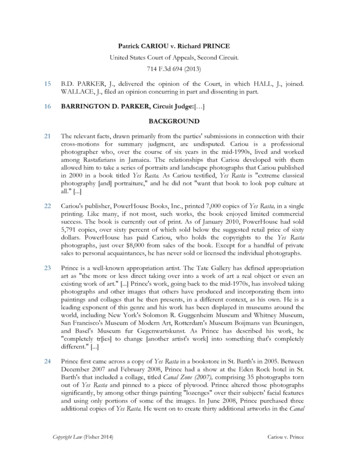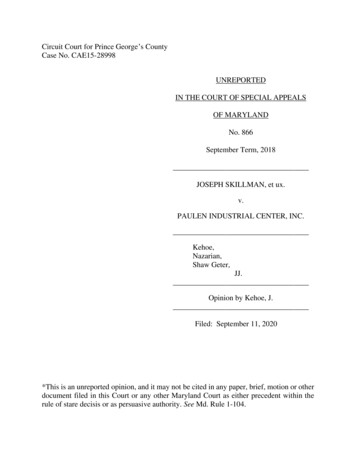
Transcription
Circuit Court for Prince George’s CountyCase No. 15-1553XUNREPORTEDIN THE COURT OF SPECIAL APPEALSOF MARYLANDNo. 1745September Term, 2017JOSEPH M. POTEATv.STATE OF MARYLANDBerger,Leahy,Eyler, James R.,(Senior Judge, Specially Assigned),JJ.Opinion by Leahy, J.Filed: July 2, 2019*This is an unreported opinion and therefore may not be cited either as precedent or aspersuasive authority in any paper, brief, motion, or other document filed in this Court or anyother Maryland court. Md. Rule 1-104.
—Unreported Opinion—Appellant, Joseph Poteat, struck up a friendship with the victim, 32-year oldMarquita Wimms, after meeting her at a tire store. He had known her for about a yearwhen she died of a fatal gunshot wound to her head. Ms. Wimms normally drove Mr.Poteat, a marijuana dealer, to his drug transactions. It was during one of these trips thatMs. Wimms lost her life.On December 16, 2015, Mr. Poteat was charged by information in the CircuitCourt for Prince George’s County with first-degree murder and use of a firearm in thecommission of a crime of violence. In advance of trial, the parties submitted to the courtproposed voir dire questions, which included, among others, a racial bias question and a“strong feelings” question. The circuit court failed to ask both questions, despite Mr.Poteat’s requests and subsequent objections. The case proceeded to a four-day jury trial,and at the close of all the evidence, the court denied Mr. Poteat’s renewed motion for ajudgment of acquittal on all counts. During the closing arguments that followed, Mr.Poteat’s counsel repeatedly stated that there was “zero” or “no DNA” from Mr. Poteat inany of the DNA samples from the crime scene. On rebuttal, the State countered Mr.Poteat’s “mischaracterization” of the DNA evidence and argued that Mr. Poteat’s DNAmatched every single location tested.The circuit court then instructed the jury, which included the State’s propoundedflight instruction, and jury deliberations commenced. The jury ultimately found Mr.Poteat guilty of first-degree murder and use of a firearm in the commission of a crime ofviolence. The court denied Mr. Poteat’s motion for a new trial and sentenced him to lifein prison for murder, plus 20 years for the handgun conviction.2
—Unreported Opinion—Mr. Poteat presents four questions1 for our review, which we have rephrased andreordered:I. Did the trial court err by not asking mandatory voir dire questionsrequested by defense counsel?II. Was the evidence legally sufficient to sustain Mr. Poteat’s convictions?III. Did the trial court err by giving a flight/concealment instruction?IV. Did the trial court err by allowing the prosecutor to mischaracterizeinconclusive DNA evidence as inculpatory during his rebuttal closingargument?We hold that the trial court erred in failing to ask the mandatory voir direquestions upon Mr. Poteat’s request. Because the State presented sufficient evidence tosustain Mr. Poteat’s convictions, we shall reverse both convictions and remand the caseto the circuit court for further proceedings consistent with this opinion. We brieflyaddress only the third issue, for purposes of guidance on remand, as it will likely arise ata new trial.1Mr. Poteat asked:1. Did the trial court commit reversible error by not asking mandatory voiredire questions requested by the defense?2. Did the trial court commit reversible error by allowing the prosecutor in hisrebuttal closing argument to mischaracterize inconclusive DNA evidence asinculpatory?3. Did the trial court commit reversible error by giving a flight/concealmentinstruction?4. Was the evidence insufficient to convict appellant?3
—Unreported Opinion—BACKGROUNDThe following facts were adduced at Mr. Poteat’s jury trial, which transpired overfour days from June 5 through June 8, 2017.The State called 15 witnesses: Ms.Wimms’s mother; Ms. Wimms’s best friend; three residents of 1950 Rochelle Avenue;Nadine Keemer, Ms. Wimms’s roommate at the time of the shooting; the crime scenetechnician; a responding firefighter and EMS supervisor; Dr. Carol Allan, the State’s“expert in pathology and forensic pathology”; an expert in latent fingerprints; a firearmsexpert; a DNA expert; Lieutenant Jordan Swonger, the State’s expert in cell-sitecommunications, cellphones, and cellphone technology; and Detective David Gurry, thelead homicide detective in the case. The jury also heard from Mr. Poteat, who testified asthe only witness in his defense.A. The Car CrashOn Saturday, October 3, 2015, around 10:40 p.m., a Volkswagen Jetta crashed intoa picket fence in a parking lot in front of 1952 Rochelle Avenue (“1952 Rochelle”), oneof the apartment buildings at the Walker Mill Apartments complex in District Heights,Prince George’s County. The car backed up, then careened down a hill, crashing throughthe patio glass doors of an apartment (“the Apartment”) at 1950 Rochelle Avenue. Whenthe car finally came to a stop, it was partially inside the Apartment and partially insidethe front lobby of the building. A tenant named Sakinah Lee lived in the Apartment andwas home with her daughter at the time of the crash.4
—Unreported Opinion—Det. Gurry reviewed surveillance footage2 from the apartment complex andinterviewed other tenants. He estimated that about “two-and-a-half to three-and-a-halfminutes” passed between the time the car initially hit the picket fence and the time the carbroke through the fence and rolled down the hill. Because the surveillance video showeddirt leading up to the picket fence, Det. Gurry believed there had been “some kind ofdistress in the car.”Ms. Lee testified that she had heard the initial crash into the picket fence about“five to eight minutes” prior to observing “[car] lights coming toward [her].” Once thecar came to a stop in the Apartment, she said, the car was “still revving[ and]accelerating.” As she was searching for a way to exit her apartment, she saw a man withdreadlocks climbing out of the car inside her apartment. She later identified the man in aphoto array as Mr. Poteat.3 When asked what portion of the car Mr. Poteat exited, sheanswered “[t]he front, I know that,” although she was uncertain whether Mr. Poteat hadbeen in the driver or passenger side of the car. Ms. Lee recognized Mr. Poteat fromhaving seen him around the apartment complex several times before. According to Ms.Lee, Mr. Poteat, whom she could see clearly, was standing a foot away from her insidethe apartment and was exclaiming, “Oh, my gosh. Where am I? What’s going on? What2The State played surveillance footage from the apartment complex at trial,showing camera angles from 1950 and 1952 Rochelle Avenue. The footage does notdepict when the car broke through the picket fence.3According to the audio recording of Ms. Lee’s 911 call played at trial, Ms. Leestated to the dispatcher that the driver was getting out of the car. She testified, however,that she was “not sure exactly who was driving and who was not driving.”5
—Unreported Opinion—happened?”Still looking for a way to exit, Ms. Lee went into a bedroom of herapartment while carrying her baby, opened the bedroom window, knocked out the screen,and prepared to hand her daughter to a neighbor who had been standing below. Beforeshe could do that, however, Mr. Poteat ran past her and jumped out of the bedroomwindow. The two were together in her apartment for one to three minutes.At this time, Mr. Poteat also encountered Chauntay Tynes, the mother of his sonand lessee of 1948 Rochelle Avenue. According to the transcript of Ms. Tynes’ 911 call,she exclaimed to Mr. Poteat: “What the [expletive] – what the [expletive] is you doing inthere? Wh[at] are you doing over there? What the [expletive] is you doing over there?”Thereafter, between 11:01 p.m. on October 3, 2015 and 12:14 a.m. on October 4, 2015,Ms. Tynes called Mr. Poteat’s phone more than 10 times, but all those calls wentunanswered.Emergency medical technicians from the Prince George’s County Fire Departmentand officers of the Prince George’s County Police Department soon arrived at the scene,having received multiple other 911 calls reporting the car crash. The first respondersdiscovered an unconscious Ms. Wimms in the driver’s seat of the car, exhibiting very“shallow respirations.” Several first responders worked for nearly 20 minutes to extractMs. Wimms from the car and eventually removed her through the passenger side frontdoor. Ms. Wimms bled as the responders extracted her from the car. The first responderstransferred Ms. Wimms to an ambulance and, while on board, an EMT discovered apossible bullet wound in front of Ms. Wimms’s right ear.6
—Unreported Opinion—Ms. Wimms died as a result of the gunshot wound to her right temple. Dr. Allan,an assistant medical examiner for the Office of the Chief Medical Examiner of the Stateof Maryland, conducted Ms. Wimms’s autopsy and certified the manner of her death ashomicide. Dr. Allan testified at trial that Ms. Wimms’s bullet “wound would have beenimmediately incapacitating and actually nonsurvivable even with medical attention[,]”although there “c[ould] be minutes of breathing[.]” Because of this, “[i]f her weight f[ell]forward and her foot had been on the accelerator, . . . it’s not going to move off theaccelerator, [] it’s going to be still be on the accelerator. . . . any weight forward wouldcause the car to keep moving.”On October 15, 2015, Ms. Lee went to the Prince George’s County PoliceDepartment to provide a written statement of the incident to Det. Gurry. At the policestation, another detective administered a double-blind photographic array to Ms. Lee,who identified a photograph of Mr. Poteat as the individual who jumped out of the carinside her apartment. Based on Ms. Lee’s identification, Det. Gurry obtained a warrantand arrested Mr. Poteat on October 20, 2015. At the time of Mr. Poteat’s arrest, he hadon his person a white Samsung cell phone (“Samsung”), which Det. Gurry seized andsubmitted to Lt. Swonger in the Prince George’s County Cell Phone Unit for analysis.On December 16, 2015, Mr. Poteat was charged by information in the circuit courtwith first-degree murder of and use of a firearm in the commission of a crime of violence.B. The Forensic EvidenceThe crime scene technician processed the Volkswagen, which was registered toMs. Wimms, and recovered the following items of evidence from the car: (1) two7
—Unreported Opinion—cellphones—an iPhone on the front passenger seat and a second iPhone in the centerconsole; (2) a loaded 9 mm semi-automatic pistol on the floorboard of the right frontpassenger seat; and (3) a fired 9 mm cartridge case near the handgun on the floorboard ofthe front passenger seat. At the scene of the crime, the technician gave both cellphones toDet. Gurry, who later concluded that the phone found in the center console of the vehiclebelonged to Ms. Wimms and the phone found in the front passenger seat belonged to Mr.Poteat.4Lt. Swonger testified regarding data obtained from the cellphone carrier of Mr.Poteat’s iPhone found in the passenger side of Ms. Wimms’s car. The call-detail recordsfor his cellphone showed that, from August 29, 2015 through October 3, 2015, ten callswere exchanged between Mr. Poteat’s cellphone and Ms. Wimms’s cell phone. OnOctober 3, Mr. Poteat’s cellphone made three outgoing calls to Ms. Wimms’s cellphonebetween 4:34 p.m. and 5:35 p.m. Ms. Wimms’s cellphone called Mr. Poteat’s cellphoneonce at 5:40 p.m.4Det. Gurry testified that he was unable to extract any data from the two iPhonesbecause both were locked with passcodes. Det. Gurry explained that a locked cell phonecan be used to make an emergency call. He used the iPhones to call 911 and then askedthe 911 dispatcher to provide him with the phone numbers that had made the calls. Usingthose phone numbers, Det. Gurry obtained the subscriber information, which showed thatone iPhone was subscribed to Mr. Poteat, and the second was subscribed to Ms. Wimms.Det. Gurry subpoenaed the call detail records from Mr. Poteat’s cellular carrier, TMobile. The cell-site location information established Mr. Poteat’s cellphone to besomewhere in the “general area” near 1950 Rochelle Avenue on October 3, 2015, around10:28 p.m.8
—Unreported Opinion—Lt. Swonger also testified about the data he extracted from the Samsung found onMr. Poteat’s person at the time of his arrest. He testified that the extraction reportindicated that the Samsung had been activated on October 5, 2015, two days after theshooting. Internet search data revealed that three days after the shooting, on October 6,2015, Mr. Poteat initiated six searches for information about a car driving into a buildingwhere the driver had been shot, and that Mr. Poteat accessed the Maryland Judiciary CaseSearch Database on 12 occasions following the shooting. On October 18, 2015, Mr.Poteat viewed six times an article titled “[S]uspect identified in District Heightshomicide[,]”5 and viewed seven times an article titled “[W]oman who died after crashinginto Maryland apartment ID’ed.” Beginning on October 5, 2015, over the course of 15days, Mr. Poteat looked at Ms. Wimms’s Facebook page 173 times.Jenna Hong,6 the State’s DNA expert, evaluated 12 samples of evidence from thescene and compared them against known DNA profiles of Ms. Wimms and Mr. Poteat.She reported the results of her analysis in a Forensic Case Report, which the Stateintroduced at trial. In elaborating on the findings in her report, she testified at trial thatshe could not conclude the presence of Mr. Poteat’s DNA on any of the 12 DNA samples.Swabs from the rear left side of the slide of the handgun above the safety, the left side of5Lt. Swonger clarified at trial that the internet search data generates the title of thearticle or website that the user visited by way of a search or internet link, but it does notgenerate the words that a user searched, or the “user inputs,” to generate the article ofwebsite.6Ms. Hong works for Bode Cellmark Forensics, a private company that contractedwith the Prince George’s County Police Department.9
—Unreported Opinion—the grip and upper back-strap area of the gun, and Mr. Poteat’s iPhone case, contained amixture of DNA and included Ms. Wimms as the major contributor while excluding Mr.Poteat as a possible major contributor. She testified that these samples also testedpositive for the presence of blood, which, being a liquid, would present higher quantitiesof DNA. 7 Ms. Hong could not draw any conclusions about “the minor alleles present inthe[se] sample[s].”8 The remaining nine DNA samples were all “touch samples,” whichmeant that the samples contained “a very small quantity of DNA” and, because manydifferent people will touch an object, often result in DNA mixtures that are difficult tointerpret. Consequently, for six of those DNA samples, which consisted of swabs takenfrom various spots on the handgun and from the inside front passenger door handle ofMs. Wimms’s car, Ms. Hong could neither include nor exclude Mr. Poteat and Ms.7The Serology Report, which the State introduced into evidence, indicateswhether an item of evidence tested positive, negative, or inconclusive for blood, but itdoes not indicate the source of the blood. As discussed, Ms. Wimms was extracted fromher car through the front passenger door. The gun and Mr. Poteat’s iPhone were on thepassenger side of the car during that extraction.For all three items of evidence, Dr. Hong’s Forensic Case Report states that“[d]ue to the possibility of allelic drop out, no conclusions c[ould] be made on the minoralleles present in [the] sample[s].” Dr. Hong did not use or define the term “alleles” inher testimony, but it was used in her report. The Court of Appeals has explained thatterm as follows:The vast majority of the base pair sequences of human DNA areidentical for all people. There are, however, a few DNA segments or genes,called “polymorphic loci,” which are highly variable among individuals.The alternative forms of these individual polymorphic gene fragments arecalled “alleles.” It is these polymorphisms that have great significance forforensic DNA analysis because they provide the basis for DNAidentification.Young v. State, 388 Md. 99, 107 (2005) (internal citations omitted).810
—Unreported Opinion—Wimms. But she testified that she was able to conclude that these samples, included “atleast one male contributor” and that Mr. Poteat was not excluded from any of thosesamples.9 Ms. Hong was unable to obtain a DNA profile with respect to the other threeDNA samples of fingernail clippings from Ms. Wimms’s hands and swabs from thehandgun’s cartridges.Additionally, the State’s expert in latent fingerprint examinations, KathleenHolshue-McNamara, examined fingerprints from the scene and testified that fingerprintsrecovered from the exterior of the right front passenger door window matched those ofMr. Poteat. She testified that fingerprint impressions from the front and rear of Mr.Poteat’s iPhone and from another location on the exterior of the right front passengerdoor window excluded Mr. Poteat, but concluded that other fingerprint impressions fromthe front of Mr. Poteat’s iPhone, the magazine of the gun, and the front passenger’soutside door handle had no value, meaning the impressions did not contain “ridgecharacteristics.”Kristina Cheung, the State’s firearms expert who examined the firearms evidencefrom the scene, testified that the fired cartridge case had been fired from the handgunfound in the car. She was unable to conclude, however, whether the bullet jacket and9According to the Forensic Case Report, Ms. Hong did not conclude whether theDNA sample of the swab from the front left portion of the slide on the handgun includedat least one male contributor.11
—Unreported Opinion—fragments recovered during Ms. Wimms’s autopsy were fired from that same handgun,10explaining that a firearms analysis could not determine who fired the handgun or whenand where it was fired.After the State rested its case, Mr. Poteat moved for a judgment of acquittal on allcounts, arguing that the State had failed to present sufficient evidence connecting him tothe shooting of Ms. Wimms. The court ruled that the State had made a prima facie caseand denied Mr. Poteat’s motion.C. Mr. Poteat’s DefenseMr. Poteat testified in his defense. Recounting his version of events on October 3,he conceded to being with Ms. Wimms prior to and during the shooting and subsequentcar crash, but denied being the perpetrator of the crime.He met Ms. Wimms at a Panda Express on the evening of October 3. They tookfood back to Ms. Wimms’s apartment where they ate, smoked marijuana, had sex twice,and watched a movie. Throughout the evening, he walked in and out of the Apartment byhimself to sell marijuana. At one point, however, a friend of Ms. Wimms knocked on theApartment door asking if he could buy marijuana from Mr. Poteat. Mr. Poteat sold theman 3.5 grams of marijuana, but the friend returned about an hour later to ask if he couldpurchase two more ounces of marijuana, which Mr. Poteat did not have. This promptedMs. Wimms, Mr. Poteat and the man to leave Ms. Wimms’s apartment to drive to get10Ms. Cheung testified that the fragments and the lead core from the handgun“lacked marks of value for microscopic comparison”12
—Unreported Opinion—more marijuana from Mr. Poteat’s apartment at 1948 Rochelle Avenue, the apartmentleased to Ms. Tynes.11Mr. Poteat testified during direct examination that Ms. Wimms drove, the friendsat in the front passenger seat, and he sat in the back seat on the passenger’s side.According to Mr. Poteat, while in the car, the friend “pulled out a gun on [Mr. Poteat andMs. Wimms],” and took Mr. Poteat’s phone, money, and car keys.Ms. Wimms,frightened and shaking, “just let the car coast[,]” prompting the friend to “g[e]t agitatedand [] hit her. . . with the butt of the gun[.]” The friend then “told her to back the fuckingcar up,” which Ms. Wimms did without looking, crashing into the picket fence in theapartment parking lot. She slammed on the brakes, causing the car to jerk. “[W]hen itjerked,” the friend “shot her[,]” although Mr. Poteat did not initially realize it. After Ms.Wimms was shot, he testified, he lunged towards the man, who managed to climb out ofthe car and run away at the “top of the hill when the car backed up,” leaving behind theitems he had stolen. The car then rolled downhill, hitting the apartment building. Mr.Poteat claimed he tried to put the car in park, but the emergency brake was ineffective.According to Mr. Poteat, after the gun went off, it all “happened so fast,” estimating thatit was “some seconds” before the car began rolling down the hill. He lost consciousnessand awoke in the car, hearing people screaming. At that time, Mr. Poteat began kickingthe door of the car to try and get out.11On rebuttal, the State recalled Det. Gurry, who testified that defense counsel hadnoticed its intent to call Ms. Tynes as an alibi witness, providing 1948 Rochelle Avenueas her address.13
—Unreported Opinion—Once out of the car, he ran past Ms. Lee and jumped out of her window becausehis “main concern” at that moment was getting out of the apartment. He rushed past Ms.Lee because she was rather nonchalantly talking on the phone and smoking a cigarette,and “[s]he wasn’t even trying to get out of the house.” Mr. Poteat was also havingtrouble breathing from the smoke, and all of the neighbors at the scene were yelling thatthe car was going to explode. He further testified that once he jumped out of the window,a neighbor brought him into his apartment in the building next door.On cross-examination, Mr. Poteat testified that up until the moment the car jerked,the friend, seated with his back leaning against the door, was pointing the gun at him.When the car jerked, Mr. Poteat testified, the friend “pointed [the gun] at [Ms. Wimms]and shot her.” When the State asked Mr. Poteat exactly where “the muzzle of the gun[was] in relation to Ms. Wimms’[s] head at the time the gun was fired,” Mr. Poteatanswered “I don’t remember. I was scared.”At the close of all the evidence, Mr. Poteat renewed his motion for judgment ofacquittal on all counts, reiterating that the State failed to present evidence sufficient toshow Mr. Poteat’s “involvement in the shooting of [Ms.] Wimms.” The court denied themotion.D. Jury VerdictAfter deliberating for less than two hours, the jury found Mr. Poteat guilty of bothcharges.On June 19, 2017, Mr. Poteat moved for a new trial under Maryland Rule 4-331,arguing that (1) legally insufficient evidence supported his conviction; (2) the court failed14
—Unreported Opinion—to ask mandatory voir dire questions; and (3) the prosecution misinterpreted the DNAreport during closing argument and introduced inadmissible character evidence. Thecircuit court denied the motion at the October 6, 2017, sentencing hearing. The courtsentenced Mr. Poteat to life in prison for the first-degree murder conviction, and 20 yearsin prison for the handgun conviction, the first five years mandatory and to be servedconsecutively to the murder sentence. Mr. Poteat noted his timely appeal to this Court onOctober 19, 2017.We shall include additional facts as necessary throughout our discussion of theissues.DISCUSSIONI.Voir DireIn advance of trial, the parties submitted to the court proposed voir dire questionsin writing. Relevant to this appeal are Questions 3 and 9. In Question 3, Mr. Poteatrequested that the court ask the venire: “[i]s there any reason that you believe that youcannot fairly consider and decide charges brought against an African American?” InQuestion 9, Mr. Poteat requested that the court ask the following: “[t]his case involvesallegations of [] murder. Do you have any beliefs, values, attitudes, or concerns thatwould make it difficult for you to fairly assess the legal merits of this case, or that wouldotherwise make it difficult for you to serve as a juror on this case?”At trial, the judge asked the jurors a series of questions during voir dire. The trialjudge did not ask proposed Questions 3 and 9, but instead asked a more general question:15
—Unreported Opinion—Ladies and gentlemen of the panel, I’ve asked a number of questions anumber of different ways; however, we can’t get into everybody’s head,and I would never even try because I don’t want anybody getting into minebecause you’d find there’s nothing there. Nonetheless, is there anyoneamongst you who may know something about yourself that what you knowabout yourself may preclude you from sitting in this case and being fair,impartial, and basing your decision solely on the evidence presented in thiscase and nothing else? If so, please stand.(Emphasis added). The court then asked both the State and defense counsel if they weresatisfied with voir dire and the following colloquy ensued:[DEFENSE COUNSEL]: Question three about Africa[n] Americans.THE COURT: State?[PROSECUTOR]: I just need to clarify. What he’s asking is if somebodycan’t be fair and impartial because of the person’s race?[DEFENSE COUNSEL]: Yes. African American.THE COURT: I asked the general question.[DEFENSE COUNSEL]: We want specifically African American.THE COURT: Okay. Next.***[DEFENSE COUNSEL]: Number nine, this case involves allegations ofmurder. Do you have any personal beliefs or attitudes, number nine.THE COURT: Okay. Next.The court declined to ask either question.Mr. Poteat argues, and the State concedes, that the circuit court was required toask the requested voir dire question on racial bias. Mr. Poteat also argues that the circuitcourt was required to ask Question 9, a mandatory “strong feelings” question. The Stateneither refutes nor addresses this argument with regard to the “strong feelings” question16
—Unreported Opinion—“because the trial court’s refusal to ask a racial bias question necessitates reversalregardless.”The abuse of discretion standard governs our appellate review of a trial court’sconduct of voir dire. Collins v. State, 463 Md. 372, 391 (2019).A. Racial Bias QuestionThe Court of Appeals’s decision in Hernandez v. State, 357 Md. 204 (1999) turnedon the issue of a requested voir dire question on racial bias. In that case, the Courtoverturned the conviction of an Hispanic male for child abuse and second-degree rape.Id. at 206. At trial, Hernandez requested a voir dire question that read: “[i]s there anymember of the panel who would be prejudiced against a defendant because of anydefendant’s race, color, religion, sexual orientation, appearance, or sex?” Id. at 206-07.The trial judge refused to propound Hernandez’s question, despite the State’s admonitionthat the court ask it. Id. at 208. Instead, the court asked the more general question of“whether any of the prospective jurors have any bias or prejudice either for or against thedefendant.” Id. at 207 (internal quotations omitted). At a hearing for Hernandez’smotion for a new trial, which was three months before the jury rendered a guilty verdict,“Hernandez was first expressly referred to as being of the ‘Hispanic’ race.” Id. at 209.On appeal to this Court, Hernandez presented, inter alia, the issue of whether “thetrial court err[ed] by refusing to propound a requested question on voir dire relating toracial bias.” Id. at 209. This Court affirmed in an unreported opinion, concluding that“it is not an abuse of discretion if the substance of the information sought by the defenseis fairly covered by another question asked by the court.” Id. at 209 (internal quotations17
—Unreported Opinion—omitted). The Court of Appeals granted certiorari to address whether “a non-specificquestion regarding bias [is] sufficient voir dire in the trial of a Hispanic defendant whenboth the defense and the prosecution request that the court propound a specific questiondesigned to elicit racial bias?” Id. at 209-10.The Court of Appeals held that “a voir dire question as to bias against persons ofthe defendant’s race should have been asked.” Id. at 225. In doing so, the Courtannounced that “any defendant, of whatever race, is entitled to have the trial courtpropound a requested voir dire question specifically directed at uncovering racial bias.”Id. at 225. The Court explained that such requests trigger a duty on the trial court tosubmit a voir dire question related to racial bias. Id. at 224-25. Notably, the Courtrejected “the trial court’s general question on bias” as insufficient to cover racial bias:Merely asking general questions, such as, “is there any reason, why youcould not render a fair and impartial verdict,” is not an adequate substitutefor properly framed questions designed to highlight specific areas wherepotential jurors may have biases that could hinder their ability to fairly andimpartially decide the case. Those voir dire questions, however, should beframed so as to identify potential jurors with biases which are cause fordisqualification, rather than merely identifying potential jurors withattitudes or associations which might facilitate the exercise of peremptorychallenges.Id. at 226 (emphasis added) (citation omitted). The Court agreed with Hernandez thattrial courts do not have the same duty to submit a voir dire question specifically18
—Unreported Opinion—concerning the accused’s race, “absent a specific request from the defendant[.]”12 Id. at227 (emphasis added). The Court explained:If Hernandez sought a voir dire question directed to prejudice againstHispanic persons, it was his obligation to identify himself as such and torequest an inquiry on bias against Hispanics. Had he done so, he wouldhave been entitled to having that question asked, without the need forspecial circumstances, in the same manner as if the request relate to race.Id. at 231.Returning to the underlying case, Question 3 referred to racial bias againstAfrican-Americans. Id. at 224. Mr. Poteat was “entitled to have the trial court propounda
proposed voir dire questions, which included, among others, a racial bias . expert; a DNA expert; Lieutenant Jordan Swonger, the State's expert in cell-site . lead homicide detective in the case. The jury also heard from Mr. Poteat, who testified as the only witness in his defense. A. The Car Crash On Saturday, October 3, 2015, around 10 .











